How to Make Old Fashioned Elderberry Wine
This post may contain affiliate links. Read my full disclosure here.
These simple elderberry wine recipes are perfect for beginning home winemakers. One uses natural yeast and the other uses commercial wine yeast. Each one creates a robust red wine. The sun wine is a little sweeter with less alcohol, and the country wine is a little heartier with higher alcohol content.
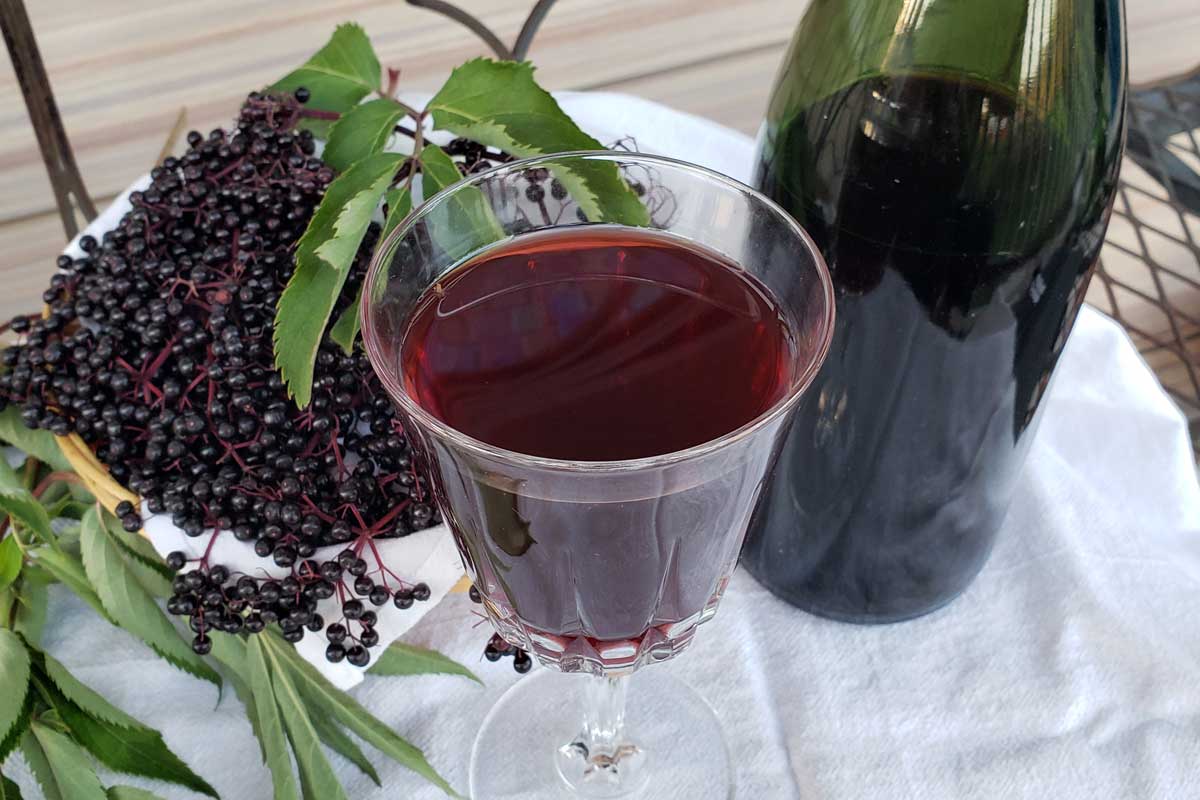
We’ll take you through the process, from gathering berries to bottling your finished product.
Side note – I’ve wanted to make homemade elderberry wine ever since I saw Monty Python’s Quest for the Holy Grail. It turned out to be a fun and tasty project.
Gathering Elderberries
When I first made elderberry wine, we went foraging for wild berries. Now we have our own elderberry patch. For making wine, use any of the following:
- American Black Elderberry – Sambucus canadensis
- Black elderberry, Sambucus nigra
- Western blue elderberry, Sambucus mexicana
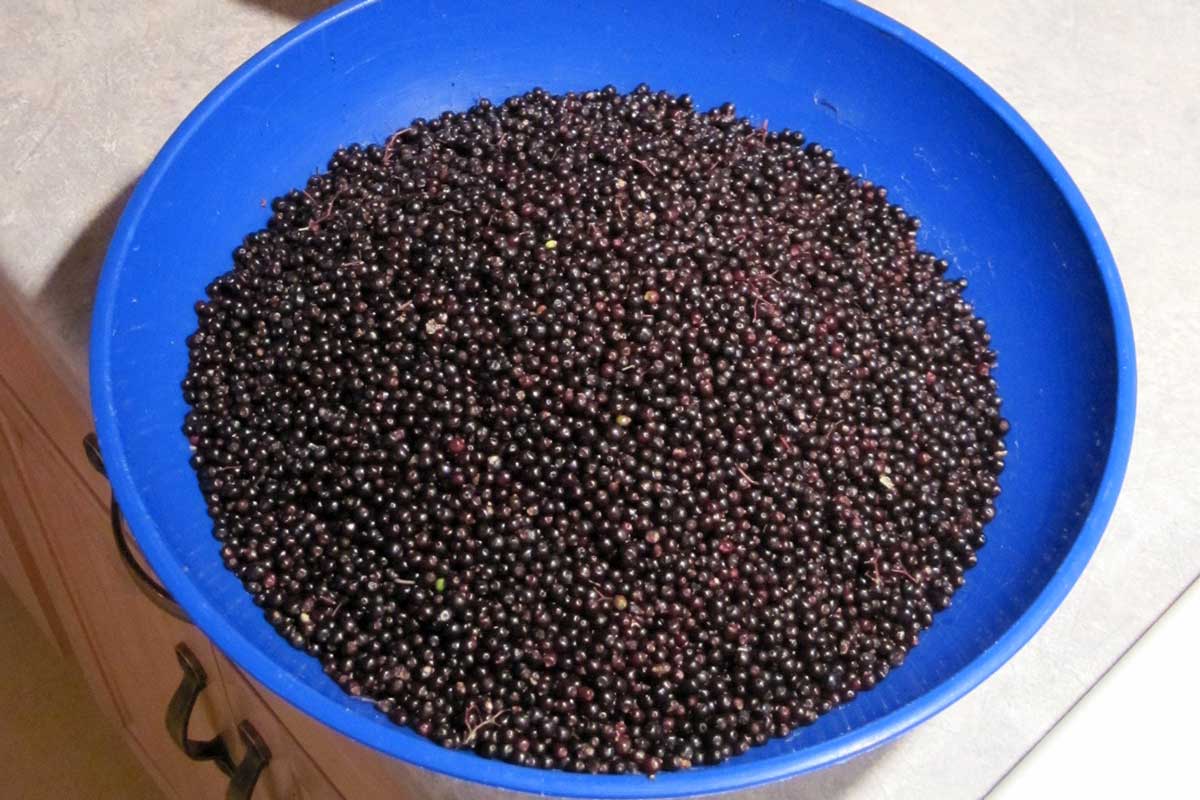
Do not make wine from red elderberries, which are toxic. For help with identification, see, “What does an elderberry plant look like?“. For those who prefer white wines, you can turn the blossoms into elderflower wine.
Harvest the berries by snipping off the clumps and gathering them in a bucket. They stain if smashed, so trying to strip off individual berries is asking for a mess. I like to tie a bucket around my waist and wade right in.
How to Clean and Process Elderberries
Once you have enough berries, strip them from the stems. A few stems is fine, but you don’t want a lot of them because they contain cyanide-inducing glycoside. (These are compounds that give rise to cyanide as the metabolism processes them.)
Elderberries are sticky, and will coat your hands and your fermenting vessels. The stems are bitter, and high in tannins. You can wear rubber gloves, but they make it a bit harder to clean the berries. Rubbing alcohol or Goo Gone will help remove the sticky coating.
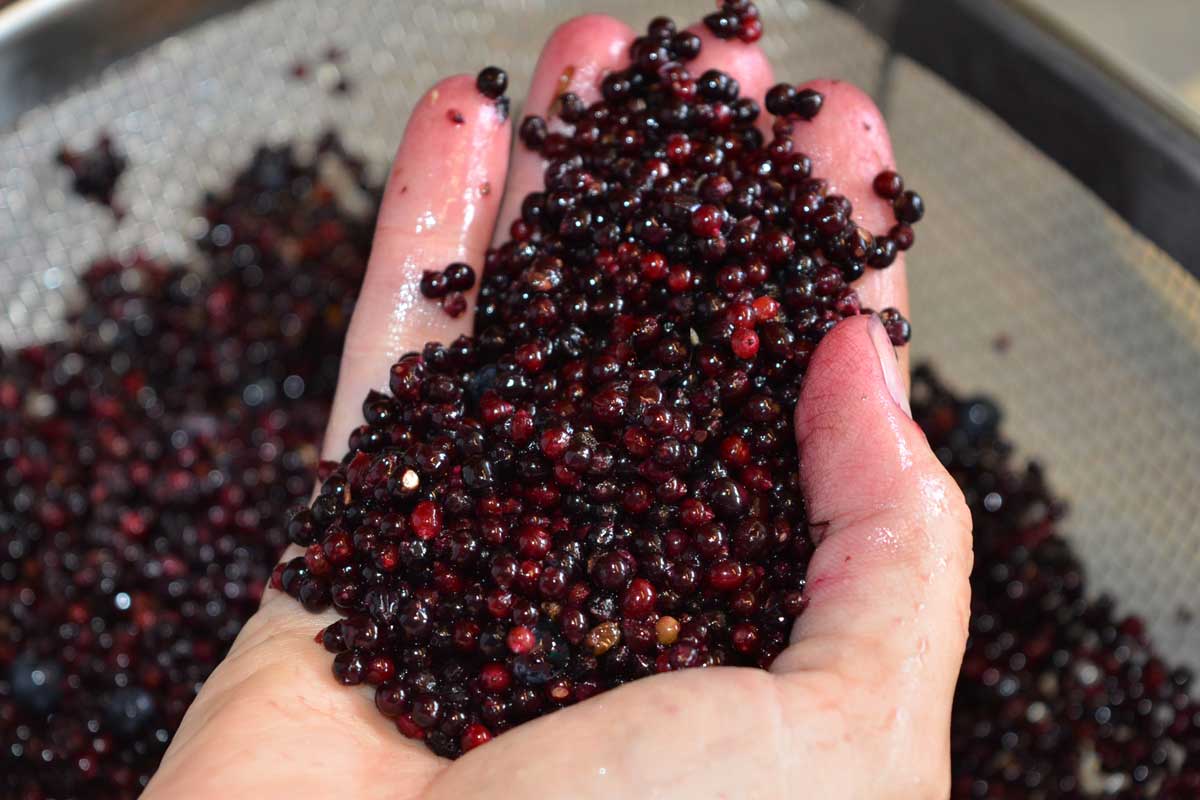
You can strip the berries off the stems with a wide-toothed comb, or use your hands. Some people freeze them before stripping the berries. If you freeze the berries first, take out a small portion at a time to process. They thaw quickly and elderberry juice can be messy.
Dried elderberries are another option. Use 5 cups of dried elderberries for one gallon of wine.
How to Make Elderberry Wine – 2 Recipes
Both of these recipes are simple country wines made with minimal ingredients and basic equipment. For the sun extracted wine, you need a gallon glass jar. For both wines, I recommend:
- 2 gallon crock, to allow room for the fermentation bubbles, or other food safe container
- gallon carboy with airlock
- 4-5 wine bottles
- a wine corker and corks
I don’t use campden tablets to stabilize our homemade wine because we are sensitive to sulfites. Campden tablets typically contain sodium metabisulfite or potassium metabisulfite. We are careful to check that fermentation has stopped before bottling.
Sun Extracted Elderberry Wine Recipe
This recipe is adapted from the book “How to Make Wine in Your Own Kitchen” from 1963. I love this little book because the recipes are so simple. The author uses common kitchen ingredients to make wine from fruit, flowers, and vegetables. It’s a fun and creative book.
This recipe is made in stages. In stage one, you steep the elderberries in water; in stage two, you add the sugar and raisins. Most natural yeasts only have an alcohol tolerance of 5-6%, so this wine has less alcohol by volume.
Ingredients
- 4 quarts loosely packed elderberries (be sure they are dark ripe)
- 2 quarts boiling water
- 6 cups cane sugar
- 1 cup of chopped raisins
Directions
Remove elderberries from stems and pack in a gallon glass jar. Bring two quarts of water to a boil. Make sure your jar is warm (you can set it in a tub of warm water) to prevent breakage.
Would you like to save this?
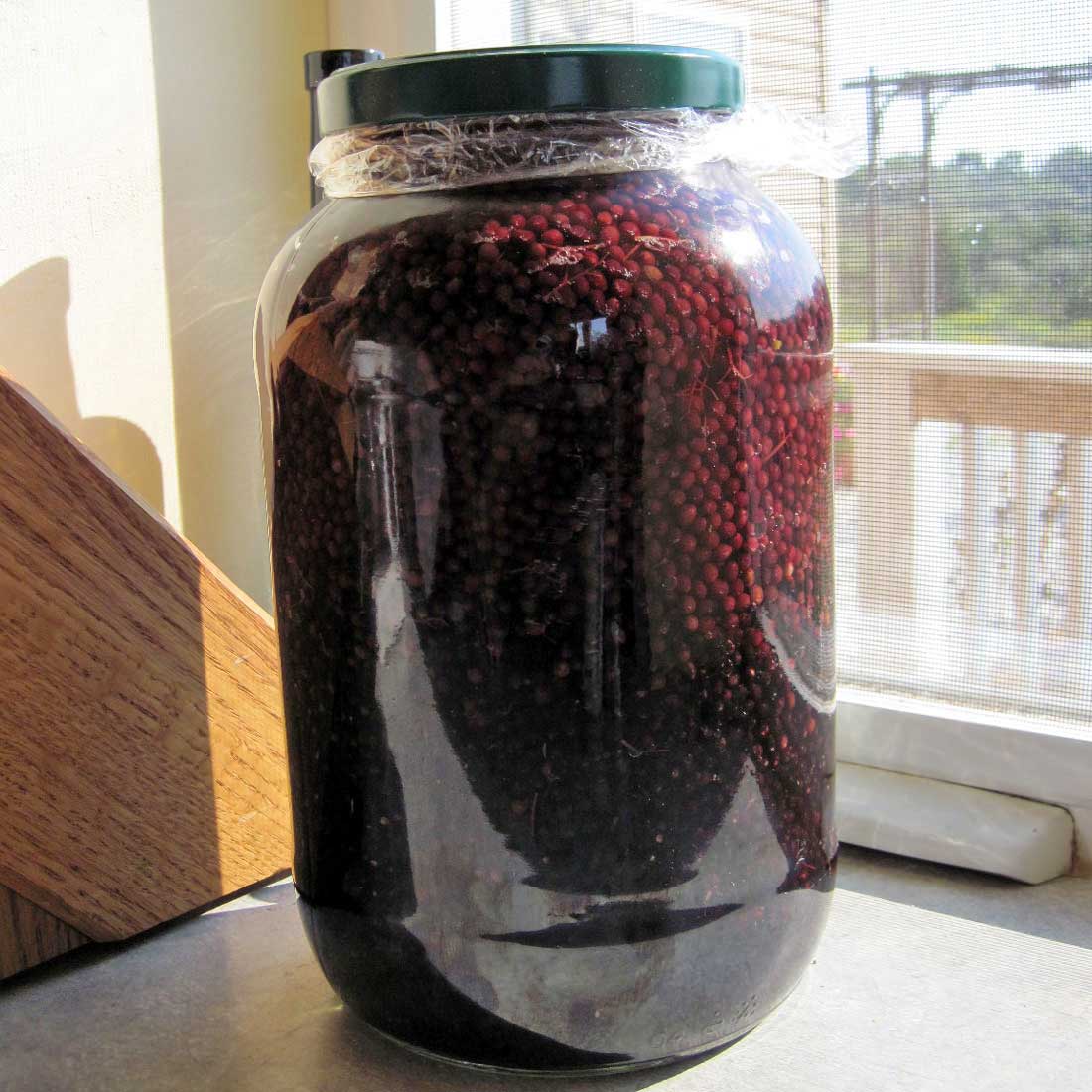
Pour the boiling water over the elderberries. Leave a healthy inch of space at the top, because they will swell and expand.
Make a plastic liner for the metal cover. Put the cover on loosely (enough to keep the bugs out, but loose enough that it can vent). Set in a sunny place outside for three days.
After three days, strain the berries through a jelly bag or flour sack towel, squeezing out as much of the liquid as possible. Pour juice back into the glass jar or a one gallon crock.
Stir in the sugar, making sure it is all dissolved. Add chopped raisins. Cover loosely and keep in a warm place indoors to continue fermentation for three more weeks.
At the end of this time period, strain the wine. Use several layers of cheesecloth, or a flour sack towel or old cotton t-shirt. Transfer the wine into a one gallon carboy with airlock. Let the wine age in the carboy for six months.
Siphon the wine the wine into bottles and allow to age until it is at least a year old. Unlike most fruit wines, elderberry benefits from longer fermentation. If you have the patience to age some of the wine longer, you will taste the difference. (See Easy Cleaning and Sanitizing and Wine Siphoning Instructions.)
Elderberry Sun Wine Notes
I set my berry jar in a sunny window, then out on the deck in various spots, and then brought it inside at night. We had a groundhog visiting the deck at night, at I didn’t want it getting in the hooch. The liquid should be bright red in color after three days in the sun.
You’ll note that this recipe has no added yeast. This made me a little nervous, since wild yeast can be less reliable. The raisins introduce wild yeast when they are added with the sugar.
If you don’t see bubbles within a couple of days, you can add commercial yeast so your wine doesn’t spoil or turn into vinegar.
PrintSun Extracted Elderberry Wine
An easy elderberry wine with just four ingredients, brewed in the sun.
Ingredients
- 4 quarts loosely packed elderberries (be sure they are dark ripe)
- 2 quarts boiling water
- 6 cups cane sugar
- 1 cup of chopped raisins
Instructions
- This recipe is made in stages. In stage one, you steep the elderberries in water; in stage two, you add the sugar and raisins.
- Remove elderberries from stems and pack in a gallon glass jar. Bring two quarts of water to a boil. Make sure your jar is warm to prevent breakage. Pour the boiling water over the elderberries. Leave a healthy inch of space at the top, because they will swell and expand.
- Make a plastic liner for the metal cover. Put the cover on loosely (enough to keep the bugs out, but loose enough that it can vent). Set in a sunny place outside for three days.
- After three days, strain the berries through a jelly bag or flour sack towel, squeezing out as much of the liquid as possible. Pour juice back into the glass jar or one gallon crock. Stir in the sugar, making sure it is all dissolved. Add chopped raisins. Cover loosely and keep in a warm place indoors to continue fermentation for three more weeks.
- At the end of this time period, strain the wine. Use several layers of cheesecloth, or a flour sack towel or old cotton t-shirt. Transfer the wine into a one gallon carboy with airlock.
- Let the wine age in the carboy for six months. Siphon the wine the wine into bottles and allow to age until it is at least a year old. Unlike most fruit wines, elderberry benefits from longer fermentation.
Picking a Commercial Yeast
In some old school recipe books, they use bread making yeast to ferment wine. This will work in a pinch, as yeasts eat sugar, no matter what the sugar source.
Now, there are many different types of yeast strains specifically for wine making. Choosing a different yeast strain allows you to adjust the alcohol content of the final product.
Yeast is available as dry yeast and liquid yeast. The dry yeasts are less expensive and good for the beginning home brewer. Some recipes include yeast nutrient, which is a mixture of nutrients that nourish yeast cells. Sometimes I use it, but I usually don’t.
Some dry yeast options for homemade elderberry wine:
- Lavlin Red Wine RC-212 – 12% – 14% alcohol
- Lavlin Champagne EC-1118 – 18% – creates a sparkling wine
- Red Star – Premier Rouge – 16%
- Vintner’s Harvest Saccharomyces Cerevisiae VR21 – 15%
- Vintner’s Harvest Saccharomyces Cerevisiae SN9 – 18%
Country Elderberry Wine
A robust red wine that’s good for sipping and as a cooking wine. Adapted from the book Wild Wine Making..
Ingredients
- 3 pounds elderberries
- 1 gallon water
- 3 pounds granulated cane sugar
- 1 package wine yeast
Instructions
- Mash the elderberries and place them in the fermentation vessel.
- Bring the water to a boil in a large pot. Add the sugar and bring back to a boil, stirring to dissolve the sugar. Add the boiling sugar water to the mixture in the fermentation vessel. Cover and let cool.
- Stir in the yeast and cover. Stir twice a day until fermentation slows, 7 to 10 days.
- Press out the pulp, pour the wine into your secondary fermentation jug, and secure the air lock. Check it the next day; if there is a deep layer of lees, rack and filter the wine. Rack again ever 2 to 3 months.
- The wine should be ready to drink in 9 to 12 months. Let it age for as long as possible before bottling, at least 9 months, and preferably a year or longer.
Notes
If desired, add 2 cups of raisins, finely chopped, with the elderberries to increase sweetness and add body.
Savoring the Elderberry Harvest
Both of these wines are rich, sweet and fruity. Heating the elderberries really brings out the berry scent, and once the yeast kicks into action it fills the kitchen with earthy, yeasty goodness.
To me it smells like abundance. If I have enough fruit for wine, then it’s a bountiful year. I’m not much of a drinker, but it’s nice to have the option to share a special brew with friends and family. Wine is quite forgiving, and so far my home wine making results have been pretty good.
We have our own elderberry patch, so we have enough berries to share with friends and try different recipes. These are some of our favorites:
- Elderberry syrup with fresh or dried berries
- Easy Elderberry Gummy Recipe
- How to Make Elderberry Jam
- Elderberry Jelly – Low Sugar and Traditional Recipes
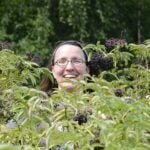
This article is written by Laurie Neverman. Laurie was raised on a small dairy farm in northwest Wisconsin, where she gathered wildflowers from the woods and pastures. She and her family now live in northeast Wisconsin, where they combine intentional plantings and semi-wild areas. Every season is a new opportunity to learn more about working with wild plants.
Originally published in August 2012, updated in 2024.







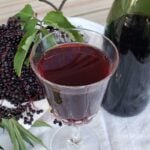
Sounds like an easy wine project. I’m curious as to know how you can get a start of the elderberry plant to grow in your backyard?? Plant some of the berries and hope for volunteers to grow up?? I’d like to try to grow some myself. Thanks Laurie!! Love your work and recipes!!
One typically starts grows elderberries by starting plants, and by taking cuttings and using those to start a new plant. You can learn more at https://commonsensehome.com/how-to-grow-elderberries/
I wonder if it is possible to decrease the sugar to make a dryer wine. I’m not a fan of sweet wines. I have 3 elderberry bushes in my yard and would like to try wine making.
I have not tried this (we drink only a small amount of wine, so I don’t make a lot of it), but it should certainly be possible to make a drier wine.
I’d cut the sugar to 5 cups, and add a teaspoon of acid blend powder for more tartness (or a tablespoon of lemon juice). You may also want to select a wine yeast specifically recommended for dry wines, like this Red Star Cote des Blancs.
I think something went horribly wrong with my first attempt of elderberry wine making. I just pulled the two one gallon jars I have on the second ferment and find little spots of mold on the top. Will this be going to the compost pile or is it salvageable and okay to bottle at this time? Please advise. Thank you.
If there’s mold I would compost it.
Did you have an airlock on top of the gallon jugs, and was the fluid level close to the top? To prevent mold during the second fermentation, the top of the bottle should be filled with the carbon dioxide from the fermentation, and not open to the air.
As far as yeast and natural fermentation goes, I think you should choose organic raisins. There are natural and healthy yeasts in raisins and grapes, but commercial raisins are often sulphated or otherwise preserved.
Try a couple of batches with organic raisins and you may not have to use commercial brewers or wine yeast.
Keith
Hey, Laurie! Would you happen to have any suggestions how to remove those tiny worms in elderberries? Shame on me but I can’t get past the ick factor but don’t want to waste the bumper crop we have this year.
I think I can soak them but in what and how much?
I suspect you’re dealing with drosophila larvae (fruit flies), and I don’t know any way offhand of getting them out, since they have a self-contained lunch buffet safely sealed inside the berries.
You could try a vinegar water or salt water soak, but unlike broccoli, they’re hiding inside, not outside the produce, so this makes them harder to remove.
We had issues with them last fall in the raspberries. It was so wet that the fruit got soft and spoiled quickly. When I kept up picking them every couple of days it was better, but the chickens got quite a few berries. I know elderberries often ripen in one flush, so that might not be an option.
Thanks! I did try the salt bath and that did remove some.
One more question, please..
I dried a second round of berries. They aren’t all black like the first batch. It’s looking like I might have “almost ripe but not quite” berries mixed in with the proper black ones. They’re not green but a burgundy color and not black. I wish I could attach a photo. Are they going to be safe to boil down with the rest? I’m my mind I’m thinking they’re not ripe enough. What’s the consensus on that?
The berries don’t all ripen evenly in the clusters, but as long as they are not completely green, I wouldn’t worry about it.
To easily remove elderberries from stems, place berries in plastic bags then put in the freezer. Once frozen cut a small hole in the bottom corner of the bag. Shake bag hard. Berries come off and you can pour them out of the bag into your pot. A few stems might come out but easy to pick out a few.
why don’t you put the weights and liquids in lbs and ozs or metric.
which home winemakers use instead of ”CUPS”
thanks
kind regards
j.jones
Because the original recipes that I used were in these measurements, and I have the measuring instruments in the kitchen, so I use “cups” all the time.
If you need a specific conversion, there are many online unit conversion tools, such as http://www.onlineconversion.com/.
I’m sorry the flowers are called Queen Anne’s Lace. Thanks
But Queen Ann’s Lace isn’t a tree. It’s a plant about 3-4 feet at the most. I think you may have sambuca which is what elderberries are and some of the flower clusters look like queen Ann’s lace. Look it up. There are lots of varieties.
I have what my mother called Queen Lace trees growing around my pond. The berries and leaves look like your picture but just want to be sure. Thanks
Queen Anne’s lace is an unrelated species. You can learn more about it here – https://commonsensehome.com/queen-annes-lace/
has anyone ever used apple juice instead of water when making elderberry wine. please let me know because iam going to make some wine as soon as the elderberrys are ready.
I haven’t tried it but I’m sure it would ferment. If you give it a go, make sure to reduce the sugar.
Hi I am in the process of making elderberry wine. After picking the berries I kept the mine the fridge for two days then froze them for three days whilst I collected some more wine making equipment. I pulled all the berries off the stems quite easily when I came to start the wine making process off as they were still a little frozen. I mashed them a bit and then began. I am in the first five days of stirring daily and to my horror have found five worms in one batch and two in the other. I have also seen a fruit fly buzzing around. The thought of the worms is putting me off going any further even though I fished them out. Should I throw it all away?
Well, that’s up to you. I’d probably lean towards composting, but if you want to try and save the batch, I’d heat it up enough to kill anything still alive in it and then add fresh yeast after it has cooled.
Hi Laurie
okay thank for your advice, the more I think about it I am veering towards composting which is a shame. I guess I should have washed them really well to start with but I was afraid of washing all the juice away.
The eggs may have been in the berries, stuck to the berries, or brought in after the brew was started. It’s hard to say, but fruit flies only need a tiny, tiny point of access, and they love wine.
I guess I was unlucky then. Maybe next year I will just pick the flowers and try to make Elder flower champagne. Thanks for your comments though.
We missed the bulk of our season this year, but hopefully next year will be better, and our own plants will finally take off so we can keep a closer eye on ripeness instead of guessing on the side of the road.
I’m drinking a little bit of homemade elderberry wine as I read this, though we make ours very differently. I hopped online to find out how to keep it from turning to vinegar and find out how long to age it. The comments were very helpful about why you wait and what time is preferable.
We make wild elderberry wine the old fashioned way, with the standard directions for making any wild fruit wine (fruit, distilled water, sugar or honey). The batch I’m drinking right now hasn’t aged yet (we just made it about a month ago and I’m transferring it to bottles today) but it is still very good. It’s not very sweet at all. I can’t remember the amount of sugar we added this time but we just used a lot of fresh elderberry juice, distilled water and sugar. We put it in a gallon ice tea jar with plastic wrap on top and a couple of pinpricks in it, burped it occasionally, then transferred to bottles on the counter with baggies rubber banded on top with pinpricks. It has a bit of a merlot flavor to it, definitely not sweet. But I’ve also had batches of wild stuff go wrong, so it’s always a crap shoot.
Today’s batch is on the counter now — two gallons of elderberry wine made according to a pamphlet I got for fruit wines at the liquor store. We’ve done this one properly with a camden tablet to kill off wild yeast, sugar, yeast nutrient, distilled water (never tap water, as the chlorine will kill yeast) and wine yeast added after a day. I’m looking forward to seeing how it compares.
Incidentally, the recipe I have from my fruit wine book only adds raisins if you use dried elderberries to start, and yes, you can use dried elderberries. The process is just a little different.
I wasn’t a big wine drinker for most of my life. I have 5 kids now and 3 of them are teenagers, and I find that I enjoy wine more and more. 😉 My husband and I find it quite fun making it ourselves and experimenting with fruits from our garden and our foraging adventures.
I tried a wild elderberry mead this fall, and I think I let it get a little too warm and it’s headed to vinegar territory. I know the commercial yeasts will actually kill off acetobacter bacteria, which is what creates acetic acid and turns the wine to vinegar.
That’s a really great recipe, I never heard of Elderberry wine and would love to try it! I used to make Elderberry syrup, I love it especially during hot days (a splash of syrup plus ice cold water). Sometimes I also mix a bit of syrup with dry white wine (can be also sparkling). I need to try your recipe!
wondering about the purpose of the grapes?
Raisins improve the mouth feel of the wine, giving it caramel elements (more with dark raisins, less with light raisins) and causing the fruitiness of the wine to linger on the tongue longer.
I’ve made plum (2 kinds) wine, blackberry wine, and mix berry wine in addition to apple cider and beer. I tried all sorts of methods for wine and they all involve adding white sugar. The reason the wine is sweet is not due to the fruit itself (anything but grapes don’t have enough fermentable sugar on their own) but rather due to the amount of unfermented white sugar added to the wine. The method I worked out for making a drier wine is to start with 1/3 of the recommended sugar for the initial fermentation and cover the jug with a balloon (I used rubber glove instead because that’s what I had) with a pin prick hole in it. When the fermentation gets going, the balloon inflates and when the sugar is running out it will start to deflate. Add another 1/3 of the sugar and cover again- the balloon will inflate again and then deflate. After it deflates and before adding the final 1/3 of the sugar, taste the wine to see how sweet it is. If it is sweet that means you’ve reached maximum alcohol content for the yeast to survive (wine yeasts will only go to about 14% alcohol by volume max) and no more sugar is needed and you’ve got a sweet wine at this point. If it is pretty dry, try adding small amounts of sugar at a time and let the balloon inflate, deflate, taste test, repeat in order to catch the wine at the point of maximum alcohol content and minimum extra sugar. The first batch of plum wine I made called for 9# of sugar for 5 gallons of must and I didn’t follow this process and it was really sweet. With subsequent batches I created this process and ended up with a much drier wine as was my preference.
As for elderberries- I’ve got 4-5 trees in the yard of the house I just moved into and I’m going to try elderberry wine this fall. And the year wait- it’s not crucial but it definitely helps mellow out the wine and reduce the “hotness” of the alcohol flavor in any wine. I’ve tried wine and cider at increments of 6 months, 1 year, and over 18 months and anything over a year is best but 6 months is drinkable. As for freezing the fruit- I found no difference between fresh and frozen for making wine. The flavor is still there if you freeze the fruit and with some fruit it makes it easier to clean (plums with their stones are a pain) if the cellular structure is compromised by freezing. Wild yeast will yield a much lower alcohol content due to the nature of the yeast itself, but I’m betting your sharing spoons transferred enough of the one yeast to the other batch. All the yeast needs is a starter and then they multiply on their own. I hope these tips help you or your readers. I found all this out by trial and error and other online forums, so I’m just spreading the info I have.
Thanks, Justin.
Can you use honey for the sugar or substitute some of the sugar for honey?
Yea, but then you’re making mead. 🙂 My friend, Colleen, has an elderberry mead recipe at http://www.growforagecookferment.com/how-to-make-elderberry-mead/.
To remove elderberries from the stalks easily and quickly use an electric drill with a clean paint stirrer in a large bucket. Add the berries on their stalks and enough water to cover. Whizz them up for about 30 seconds and strain the mixture through a coarse sieve. ( a garden riddle works well) The berries will fall off the stalks easily this way and you can then crush them in the usual way to extract the juuice
Thanks for the tip!
Thanks almost Laurie, I really don’t want to experiment and find out 6 months later it didn’t work. If I get an answer, I’ll let you know.
I’m in the same boat. The guy at the local homebrew shop suggested upping the sugar a little (maybe 10%), but didn’t have any hard and fast suggestions. As is, they wine came out pretty sweet already, so I’m not sure about more sugar.
All recipes give ingredients based on the amount of berries used in pounds ie: 1 lb or 2 lb. I’m trying to determine what the liquid equivalent would be. I have a gallon of already squeezed elderberries. Any help would be appreciated.
If you could find such a recipe, I’d love to see it, because I have some juice stashed, too.
Spray or wipe anything that is left with the green sticky residue from elderberries with cooking oil and then wash. It will come right off.
Thanks for the tip.
Sweet and yummy. Now that’s definitely a good description for a wine. At least it’s something I can tolerate. Thanks for the great ideas.
HI Laurie
Interesting story on making elderberry wine. How about a followup on how each batch turned out? Recipe preferences? What would you do different? Scale up issues? Why the year wait? Most wines are drinkable at about 6-8 months. I noticed in the story you indicated NE wisconsin. N S E or W of GB? Have you made any elderberry wine since 2012?
Scottie
Hi Scottie. I should get around to an update, but the posts get only a small amount of traffic, so it hasn’t been at the top of my to-do list. As for how they turned out – both are good, and make a sweet wine with quite a bit of kick. I think the sun extraction method had a higher alcohol content and the heavy wine was sweeter. We just opened a bottle of the sun extraction batch for solstice.
A year wait was suggested by the original recipe, and since we don’t drink much wine, I’m generally in no rush and prefer to let my wine age a year or two.
I haven’t made elderberry wine since 2012. We picked so many in 2012 that we are still working to use up all the juice in storage. Next season we will probably go again.
I haven’t attempted to scale up, because my equipment is sized best for smaller batches, and as I mentioned, we don’t drink much wine.
I live between Green Bay and Lake Michigan, but went picking west of Green Bay with friends.
I made my first batch July 2016. Celebrated Christmas with family and toasted first bottle. It was rich with flavors. More of s dinner wine. Absolute deepest color. I used white raises. No yeast.
Then last week I opened another bottle and it was absolutely stunning. Fully body, heavenly bouquet, deep rich color. My guest was in awe at the first sip.
Oh, yes the jelly is perfect breakfast delight.
Thanks for sharing your experience, Judy. Elderberry is one of my favorite homemade wines.
Holy smokes, Laurie! You really got it going on here, don’t you? I think I will start with this one because we have TONS of elderberry down on our land. You may be hearing from me with questions! Thanks, again!
This wine is quite sweet, but very yummy! I’m hoping to make another batch this fall.
Can you use dried elderberries for this recipe? If so what would the amount of dried berries equal out to?
Thanks…
I don’t think there’s any easy way to convert for dried berries, since it’s the juice you’re looking for to make the wine. You could try a simple grape juice wine and add the dried elderberries to the brew to bump up the flavor and medicinal properties.
Love the sound of these but I am trying to find a water and sugar ratio for making elderberry wine out of 16 oz. of Elderberry Extract. Do you have any tips for this? Thanks
I was looking for something similar myself for making wine from berries that had been juiced. I didn’t have much luck, but when I asked the owner of a local home brewing shop, he suggested cutting the sugar by 10% and using roughly the same volume. I ended up turning my juice into jelly and making wine out of fresh berries.
Thanks so much for posting the recipe I have looked all over for this kind of recipe. I remember my Dad trying to make wine or beer out of raisins when I was a little girl. I don’t know how it turned out but I did love the smell. Thanks again. Lana
I love the smell of winemaking, too – rich and yeasty.
Oh my goodness! Thank you for the trip down memory lane! My father made both elderberry and dandelion wines when I was young! We picked wild rose hips, too, I think for jam. I remember having tastes of the elderberry wine when I was about 8. Thanks for the post!
My momma never made elderberry, but she did make dandelion wine and blackberry wine. Like you said, good memories. 🙂
Can you use this same recipe for the blackberry wine??? I’m not sure we have elderberries readily available in SC. When I was young they were all over the place in upstate NY. :0)
Here are a couple of recipes for “Any Fruit” wine, shared by Sondra on Facebook:
Wine-makes 1 gallon
1lb fruit-any kind rinse off dirt, don’t scrub, mash just a little to get juices flowing. (We have added more fruit each batch for a more fruity flavor)
4 c. sugar
3 qts. hot (not boiling) water
1/8t. yeast-you can use baking yeast but brewer’s yeast is better
You will need a gallon jug, a big balloon (condoms work great, don’t laugh!)
Put sugar & 1-2 qts of water in jug. shake to mostly dissolve, add fruit, yeast & rest of water, give a good shake. Top jug with balloon and tape down. Set in warm, but not hot, place where it will not be disturbed. Let balloon expand & deflate. Strain well, bottle.
Be careful to keep an eye on this, you may have to replace balloon once or twice, they have busted on me before and you do not want air or fruit flies to get to it.
I do not like to add additives to our wine, this is a very dry wine. I like mine sweeter but then I would have to add something to stop fermentation (can’t remember what it is called)
Old wine recipe
You will need a large stone crock & either cheesecloth or a large towel to cover just to keep the bugs out.
1 gallon of water
1 gallon of fruit (3-4 lb. to the gallon)
Start out with 3 lbs. of sugar (it wouldn’t hurt to add 4 obs. if you like it sweeter) Extra sugar will make it stronger
Put all in stone jar/crock & set out in the sun for no longer than one week, if that long. Be sure to cover with a cloth to keep bugs out. Cover with a lid in case of rain.
Stir everyday, tasting as you go. Strain & bottle when done.
I haven’t tried these, but the wines I have made have been pretty forgiving.
I would like to try this with the abundance of sour cherries I get each year from my tree. As we are right in the middle of winter here in Canada, the cherries are in my freezer. Is it possible to use them to make wine or is fresh fruit the best option? Thanks!!
I don’t see why frozen fruit wouldn’t work.
I have an abundance of sour cherries every year. As we are right in the middle of winter here in Canada, they are all in my freezer, can I use them to try this recipe or would you recommend using fresh fruit?
Thanks!!
To prevent bugs, critters from getting in, as well as air, I use a balloon. to prevent the balloon from popping of from over inflation I used a needle to poke a small hole that allowed the excess gasses to escape. Works well for me.
Just a few questions I have,
For the 1gal receipe that sits in the sun for 3days can I use wine yeast instead of raisens, and how much should I use?
Also can I skip the wheat products or wheat yeast and still have a good wine?
Thankyou
Don’t skip the raisins. They are critical for the flavor development of the wine. As mentioned in the post, if you are avoiding wheat, you may substitute yeast nutrient. If you are using a wine or champagne yeast, there should be no wheat yeast involved.
This looks great. I have elderberries growing in my back yard, not enough to make wine yet, but one day.
Thanks for sharing!